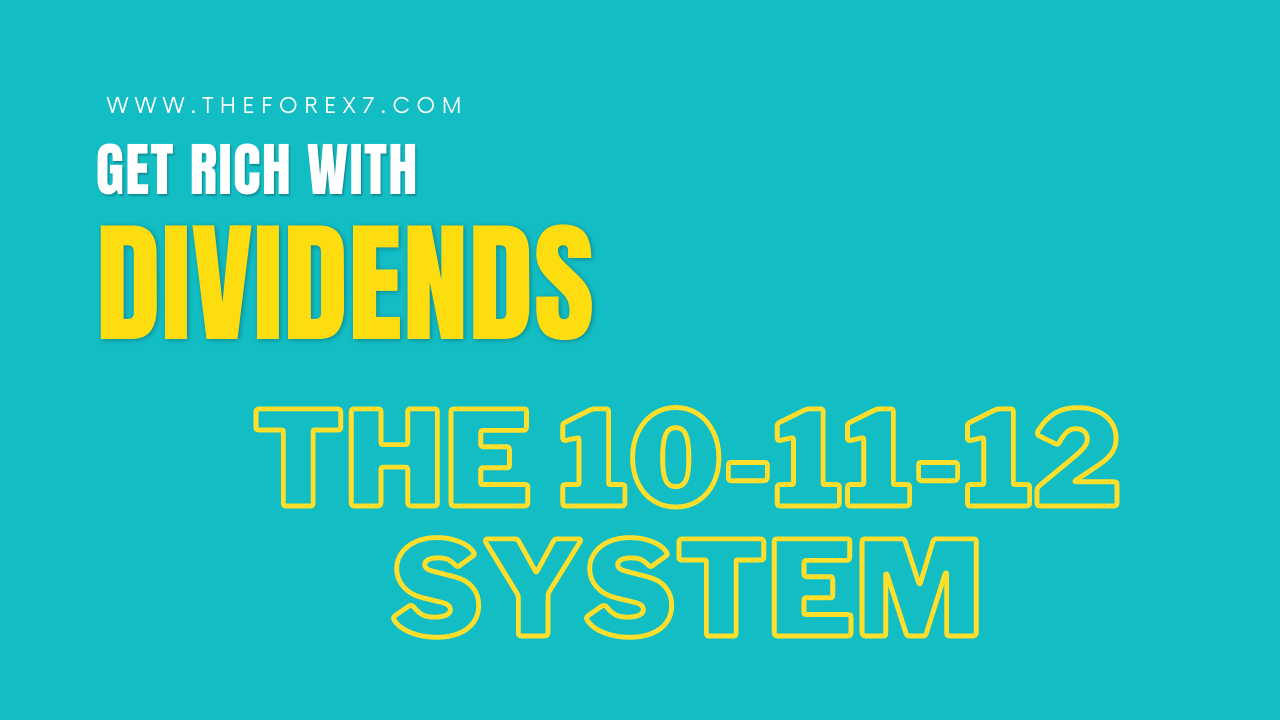Dividends Stock : The 10-11-12 System
Numbers in dividends stocks, Inflation in dividends stock, The 10-11-12 System
Course: [ GET RICH WITH DIVIDENDS : Chapter 1: Why Dividends Stock? ]

The ten-year periods ending 1936 to 1940 were brutal with an average decline of 40%. The decade ending in 1946 was much tamer with a loss of 11%. The 2008 and 2009 ten-year periods each lost 9%.
The Numbers
Investing in dividend stocks is the
best way to make money in the stock market over the long term.
But don’t just take my word for it.
Harvey Rubin and Carlos Spaht, II, both of Louisiana State University in
Shreveport, wrote, “For those investors who adopt ten-
and fifteen-year time horizons, the dividend investment strategy will lead to
financial independence for life. Regardless of the direction of the market, a
constant and growing dividend is a never ending income stream.”2
Just a few pages ago, I told you that
dogma doesn’t work, yet here I am sounding fairly dogmatic. The proof that
dividend investing creates wealth is in the numbers.
First of all, investing in the stock
market works. Since 1937, if you invested in the broad market index, you made
money in 67 out of 74 rolling ten-year periods, for a 91% win rate. That
includes reinvesting dividends.
The seven ten-year periods that were
losers ended in 1937, 1938, 1939, 1940, 1946, 2008, and 2009. The periods 1937
to 1940 and 1946 were tied to the Great Depression. The ten-year periods ending
1936 to 1940 were brutal with an average decline of 40%. The decade ending in
1946 was much tamer with a loss of 11%. The 2008 and 2009 ten-year periods each
lost 9%.
So the only ten-year periods that
didn’t make money were associated with near financial Armageddon. And even in
some decades tied to those financial collapses, such as 2000-2010, investors
still came out ahead.
Paul Asquith and David W. Mullins Jr.
of Harvard University concluded that stocks that initiated a dividend and
increased their dividends produced excess returns for shareholders.
Additionally, the larger the first dividend payment and subsequent dividend
raises, the larger the outperformance.3
And research shows that dividend stocks
significantly out perform during market downturns.
Michael Goldstein and Kathleen P.
Fuller of Babson College concluded, “Dividend-paying
stocks outperform non-dividend-paying stocks by 1 to 2% more per month in
declining markets than in advancing markets.”4
Later on in the book, I’ll show you how
you can achieve double-digit yields, which would nullify the effects of even
the weakest historical markets, performance and enable you to make money
regardless of what the overall market is doing.
Think back to other methods that I
mentioned at the beginning of the chapter: value, growth, and technical
analysis. They all work—sometimes. No system, strategy, or methodology that I
know of has a 91% win rate that can approach 100% when the dividends have been
reinvested.
Oh, I know, but it’s different this
time. We’re in an unprecedented period of debt, unemployment, financial crises,
and everything else unpleasant under the sun.
Things were pretty lousy in 2008 and
2009, with the entire financial system on the precipice of collapse.
Nevertheless, the market came roaring back, doubling in two years.
Similarly, there was little to get
excited about during the 1970s—with mortgages and inflation in the teens and
each U.S. President less popular than the last. Yet the ten-year return on the
market was positive every year throughout the 1970s and 1980s (encompassing
years from the 1970s).
Since 1937, the average cumulative
rolling ten-year total return on the stock market is 129%. This includes the
seven negative ten-year periods. Since 1999 (the first year the ten-year data
was available), the S&P Dividend Aristocrat index’s ten-year rolling return
average has been 187% and was positive every year, with the lowest ten-year
return of 40% in the period ending in 2008 (when the market tanked 38% that
year), compared to a 9% loss for the S&P 500 in the ten years ending 2008
(and a loss of 26% when you exclude dividends). I’ll explain what a Dividend
Aristocrat is in the next chapter.
I recently read a government official’s
estimate (and we know how accurate they usually are) that, over the next ten
years, stocks will lose 13% due to baby boomers taking their money out of the
market.
I don’t think that’s likely. As I’ve
shown you, historically, there’s a 91% chance of the market giving you a
positive return over ten years. Additionally, where are the baby boomers going
to put their money? Bonds are paying ridiculously low interest rates right now.
Is it worth it to lock up your funds for ten years to earn 2%? That won’t even
keep up with inflation.
For that little, I’d rather invest in a
stock with a 4% or 5% yield and take the risk that in ten years, the stock will
at least be where I bought it today.
But you know what? Even if the stock
falls, you can still make money.
Let’s assume you buy 500 shares of
stock at $20 for a total of $10,000. It pays a dividend of $1 per year or a
yield of 5%. Now, this company has a long history of raising its dividend every
year. Over the next ten years, it raises the dividend by an average of 5% per
year.
Let’s also assume that the government
official was right and the stock tracks the market and falls 13%.
If you reinvest your dividends for the
next ten years, while the dividend is increasing and the stock price is
falling, you’ll wind up with about $17,000. That’s a 70% increase, or a
compounded annual growth rate of 5.45%—despite a decline in stock price of 13%!
But what if you invested in a ten-year
treasury, paying 2% per year? After ten years, you get your $10,000 back, plus
you’ve collected $2,000 in interest for a total of $12,000, or a compound
annual growth rate of 1.84%.
So in this example, your stock
investment lost 13% in price yet still nearly tripled the performance of a
ten-year bond where your principal is guaranteed.
Think about that for a moment. Your
stock lost value, but because you reinvested your dividends, you nearly tripled
your return on the guaranteed principal of the ten-year bond. And that takes
into account a drop in the market over a ten-year period that would be equal to
the fifth largest in the last 74 years.
Oh, and if you decide after ten years
to start collecting the dividend instead of reinvesting it then, you’d receive
$1.63 per share, up from $1 per share. And because you reinvested the
dividends, you’re collecting that $1.63 per share on 1,000 shares instead of
your original 500. So your yield is going to be over 16% on your original
investment. This alone should convince you to run out and buy dividend stocks.
As they say on TV, but wait, there’s more.
Keeping Up with Inflation
People don’t talk much about inflation
these days. Since 1914, the average inflation rate in the United States is 3.4%.
In 2009 and inflation was well below the historical average. The year 2011 saw
a return to more normal levels.
Inflation of 3.4% seems pretty tame,
especially for any of us who remember the 1970s and 1980s when inflation hit
double digits. But even at 3.4%, your buying power is cut in half after 20
years.
Because inflation is low today, people
underestimate its erosive powers. Despite the fact that for the past decade
inflation has averaged nearly three quarters of a point below the historical
3.4% figure, buying power has still been cut.
What would have cost $1,000 in 2001
cost $1,270 at the end of 2011.
And what if you’re saving for something
whose price rises faster than the average 3.4% rate, such as college tuition or
retirement (and the associated medical costs)?
For example, in 2011, the College Board
reported that tuition at public four-year universities increased 8.3%. And
since 2006, it has risen at a rate 5.1% above the inflation rate.
Where are you going to find an
investment that will grow 8.3%? Today, if you lock up your money for 20 years
in a treasury, you’ll be lucky to get 3% per year.
Let’s see how cost increases could
impact tuition fees in the future. Right now, tuition for in-state students at
a public university averages $8,244. Private university students are paying an
average of $28,500. If those tuitions continue to increase by 8.3% per year, in
18 years, you’ll have to shell out $34,629 per year for the public university
and $119,717 for the private school. And that doesn’t include room and board
(or beer). Sure hope your kid can hit a jump shot.
So if you’re lucky enough to be able to
buy $100,000 worth of treasuries for your newborn child’s education, and they
pay 3% per year, you should be where you need to be to pay tuition for four
years, but you’ll still have to come up with some cash for room and board,
books, and more (beer). But remember, this is just an in-state school. At the
private university, forget it. You need to average a 9% compound return per
year to hit your target.
This is an extreme example, but you can
see that treasuries are a tough way to fund any future expense. One of the
problems with fixed income is that you can’t reinvest it in order to let it
compound, the way you can with dividend stocks.
As you’ll soon see, a 12% compounded
annual return is readily achievable when you invest in stocks that pay
dividends. In fact, if you reinvest those dividends, there is no reason why you
shouldn’t be earning 12% per year, over the long run.
12%. That was not a typo. You can earn
that much per year (and even more) by investing in boring, large-cap,
dividend-paying companies that simply match the overall return of the market.
And at 12% per year, all you need to do is start off that college fund with
$1,000 and add $2,000 per year and the in-state school is entirely paid for by
the time your little boy or girl graduates high school.
We’re not taking any extra risk here. We’re not investing in speculative companies with new technologies that may or may not work. All we are doing is trying to match the market with companies that have a long track record of paying shareholders. But through the system I’m about to show you, it can help you achieve your financial goals. You need to know which types of dividend stocks to buy in order to achieve the maximum returns. So now, let me show you.
The 10-11-12 System
When I started the process of writing
Get Rich with Dividends, my objective, besides spreading the gospel of dividend
investing, was to give readers a process for achieving their financial goals.
The process had to have three simple but key components.
- It had to be easy to understand and implement.
- It had to work.
- It had to be inexpensive.
I’ve read truckloads of financial books
and products in my life-time, many claiming to have an easy system that would
make me rich. The problem was they usually didn’t work. Often they weren’t easy
to use, nor were they cheap.
For example, one book I read
recommended buying tax lien certificates and explained how I could make 16% per
year on those investments.
Maybe somebody has achieved those kinds
of results, but when I checked with offices of various county governments
around the country that were selling those certificates, I found I’d be lucky
to make a few percentage points on my money. And the process was far from easy
or inexpensive.
Other strategies have recommended
changing my entire portfolio every year, incurring hundreds of dollars in
commission charges, even with a cheap discount broker.
So I set out to create a system for
investors that would be so easy to use and so inexpensive, they’d be free to
devote their energies to things that really excite them, like their families,
friends, work, hobbies, rather than having to spend countless hours working on
and constantly adjusting their portfolios.
If you’re the kind of person who likes
to check stock quotes during the day, research companies, and follow business
news— that’s great. You and I will have a lot to talk about if we meet.
But most people want to invest and more
or less forget about it, checking in only occasionally to make sure everything
is going according to plan.
The result is the 10-11-12 System. It
is designed so that, in ten years, the investor will be generating 11% yields
and will have averaged a 12% annual return on his or her portfolio. Just to be
clear, you won’t achieve a total return of 12% in year 1. But by year 10, your
average annual return over the entire ten-year period should be 12% and quite
possibly higher.
It is so easy to use that my
ten-year-old son instantly grasped the concept and was excited about its
prospects for his money when I explained it to him. He took his birthday and
allowance money and bought shares in the kind of stocks I talk about in the
book, understanding his funds should more than double by the time he gets to
college.
And other than the commission on buying the stocks when you set up the portfolio, it doesn’t have to cost you anything after that. Simple, easy to use, and it works.
For example, Southern Company (NYSE:
SO), which has raised its dividend every year for the last ten years, returned
193% over the past ten years when dividends were reinvested. This is a
real-life example, not theoretical. A $10,000 investment was worth $29,332
versus the S&P 500, which would have been worth $13,931.
So let’s get started so you can begin
earning 12% returns right away.
SUMMARY
- Save money—try to save 10% of your income to put to work in dividend-paying stocks. If you can’t save 10%, start smaller and work your way up.
- Investing in dividend-paying stocks is the best way to create wealth in the stock market.
- Dividend stocks will help you beat the ravages of inflation, unlike treasuries.
- The 10-11-12 System is designed to generate 12% annual returns over the long term, cost next to nothing, be extremely easy to implement, and take up very little of your time over the many years you’ll use it.
- Roy Jones Jr. made one of the worst songs in the history of recorded music.
GET RICH WITH DIVIDENDS : Chapter 1: Why Dividends Stock? : Tag: Stock Market : Numbers in dividends stocks, Inflation in dividends stock, The 10-11-12 System - Dividends Stock : The 10-11-12 System

